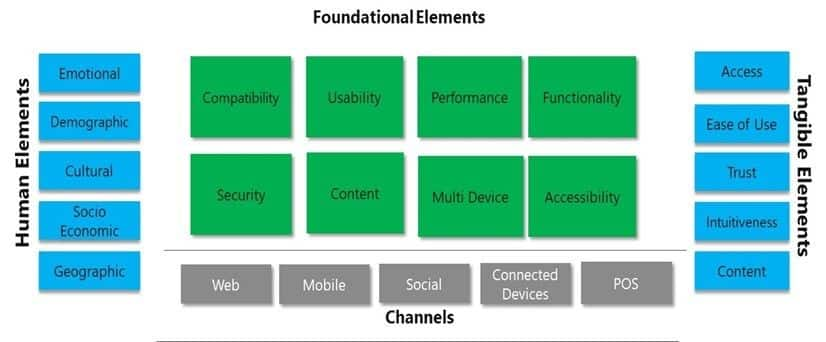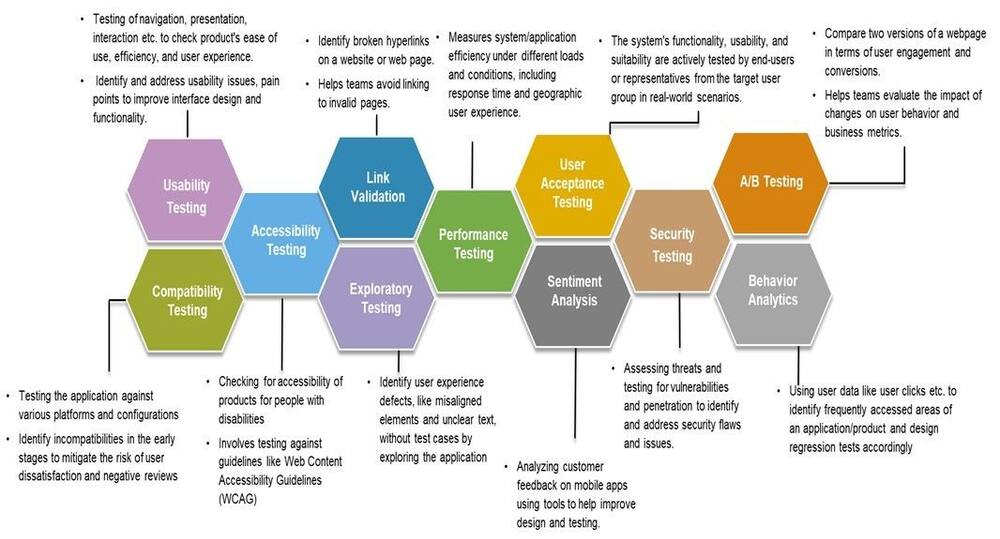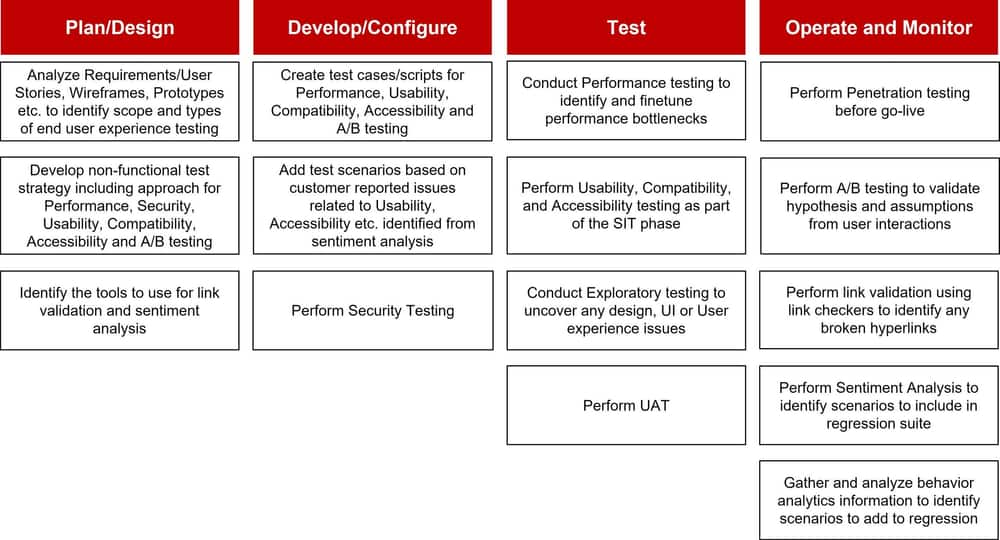Purpose
The purpose of this document is to outline the testing approach, types of testing, tools, and key considerations for end user experience testing.
Target Audience
QE Chapter Leader, Release Quality Manager, QE Architect, QE Specialist (Functional SME), and Accessibility Test Engineer (ATE).
Definition
End-user experience testing evaluates how users interact with digital products like mobile applications, websites, and other products. It aims to measure user satisfaction, ease of use, performance of the applications on different devices and identify areas for improvement, making the product more user-friendly, accessible, and efficient.
Objectives
The key objectives of conducting end-user experience testing are:
Ensure a seamless application and product experience across all devices and platforms.
Understand the target audience's needs and expectations.
Make informed decisions about product design.
Expanding channels to aggregate & analyze end-user feedback.
Increase product adoption and user advocacy.
Build long-term digital loyalty among consumers.
Testing Approach
Key Considerations
The key foundational elements in a product or application that has a bearing on the end user experience are the following:
Compatibility
- ensuring the product can work seamlessly with various browsers and operating systems.
Usability
- making sure that the product is intuitive and easy to use.
Performance
- relates to the speed and responsiveness of the product.
Functionality
- which encompasses the range of features and capabilities of the product.
Security
- protecting user data and preventing unauthorized access.
Content
- includes the quality and relevance of the information provided in the product.
Multi-Device
- product can be used across different devices and platforms.
Accessibility
- how the product can be used by people with disabilities or other limitations.
When conducting end-user experience tests, it is important to consider foundational elements and human elements like emotions, demographics, and culture, as well as tangible elements like access and ease of use. These factors should be evaluated across various channels, including web and mobile applications, social media, connected devices, and Point of Sale (POS) systems.

Types of Testing
Following are the tests and insight methods that are applicable for end user experience testing. Based on business need, QE teams will employ one or more of these type during the product lifecycle for end user experience testing.

Types of Testing - Detailed View
Refer to the links enclosed below to understand more about the following testing types.
| Testing Type | Reference Link | Tools |
|---|---|---|
Usability Testing |
-
|
|
A/B Testing |
-
|
|
Compatibility Testing |
Browser Stack, Sauce Labs (for validating web application compatibility) Android Emulator, iOS Simulator (for mobile application compatibility) |
|
Accessibility Testing |
Accessibility Testing | Tools |
|
Performance Testing |
||
User Acceptance Testing |
-
|
|
Security Testing |
|
Besides the testing mentioned in the above table, the QE team will also perform the following types of testing and analysis as part of the end user experience testing.
Link Validation
- Link validation entails the use of link checkers to scrutinize web pages and identify any broken hyperlinks.
- Broken links can be a major inconvenience for users, leading to invalid pages and disrupting the overall user experience.
- By conducting this testing process, the QE team and developers can identify and fix any broken links before the web application goes live, improving the website's overall quality and enhancing the user experience.
- Tools: Sitechecker, Semrush
Exploratory Testing
- Exploratory testing is a method of uncovering defects in the user experience of an application.
- It involves an unscripted and spontaneous approach to examining the application without relying on predetermined test cases.
- This type of testing is particularly useful for uncovering any flaws in the application's design, user interface, or user experience, such as misaligned visual elements and unclear text that may negatively impact its overall functionality and performance.
Sentiment Analysis
- This type of analysis involving using tools like Appbot to scan app stores, social media sites, and other platforms for feedback from users about the products or applications.
- QE and the project team can analyze and organize the comments into categories such as Functionality, Usability, Performance, Business/Service, and New Requirements.
- QE team can then add relevant test cases to the test suite based on the top issues in each category, including Functionality, Usability, Accessibility, and Performance of the applications.
- This method provides multi-channel assurance by addressing concerns from users who experience issues with specific devices or device-OS-browser combinations.
- Tools: Appbot, AppFollow
Behavior Analytics
- Entails gathering and analyzing both quantitative and qualitative data from users to gain insight into their behavior and interactions with web and mobile apps.
- This information helps the project team and the QE team identify the frequently accessed areas of the application or product through user clicks, mouse movements, navigation, and scrolling.
- Using this information, the QE team will be able to design the regression test suite to ensure comprehensive test coverage for these critical application areas during testing.
- Tools: Hotjar, Mouseflow
Recommended Approach for Performing End User Experience Testing
| Recommended Approach | Applicable for Testing Types | Description |
|---|---|---|
Crowd Testing
|
|
Crowd testing is a process where applications are tested by a diverse group of individuals from various locations, ages, and skill sets, using different devices and browsers. Here are the steps to follow when conducting crowd testing:
|
Tools/Analytics
|
|
Link Validation
Sentiment Analysis
Behavior Analytics
A/B Testing Refer to the below link for more details |
QE Testing
|
|
Refer to the below links for more details |
End User Experience Testing Activities in the Project Lifecycle
The diagram below captures the end user experience testing activities performed in the project lifecycle.





